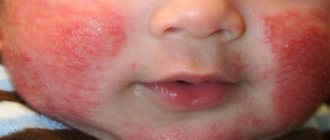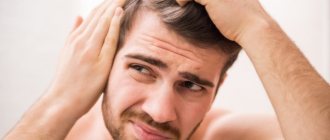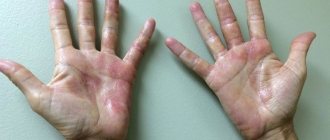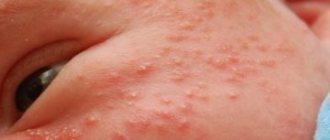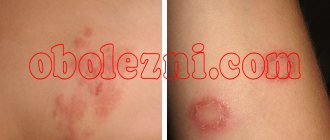Weeping dermatitis is a dermatological disease of an inflammatory nature. Accompanied by the formation of bubbles (vesicles) on the skin filled with serous or purulent exudate, that is, liquid. In terms of symptoms, the disease resembles weeping eczema, but it has distinctive symptoms. With dermatitis, the deeper layers of the skin are affected, and with eczema, the outer layers are affected. The disease occurs with equal frequency in people of all age groups. Anti-inflammatory, hormonal, emollient, and antiallergic drugs are used for treatment.
Locations of dermatitis
The disease is localized differently in patients of different ages.
In children under 3 years of age, weeping cracks mainly appear on the bends of the knees, elbows, and face. In other areas, manifestations of the disease rarely occur.
In children from 3 to 12 years of age and adolescents, characteristic lesions appear on the backs of the hands, the skin of the neck, and also in the bends of the knees and elbows. In addition to the appearance of weeping ulcers, problem areas are characterized by the appearance of compactions, swelling and severe redness.
A distinctive feature of the course of the disease in adolescents is that symptoms can sharply worsen or, on the contrary, suddenly disappear - this is due to hormonal changes in the body during this period of the patient’s life.
Adults suffer from erosions and ulcers in skin folds, on the neck and face, hands and wrists.
The course of pathology in an adult
Weeping dermatitis is characterized by the formation of a lesion in the deep layers of the dermis and the appearance of significant inflammation of the skin. The main symptoms of the disease are:
- rashes in the form of vesicles on the surface of the skin,
- separation of fluid (ichor) from the blisters (in case of infection, pus is released),
- swelling of the skin.
In adult patients, the disease manifests itself as extensive redness and irritation of the epidermis, on which oozing blisters gradually form, transforming into small ulcers and eczema with a cracked crust . Skin lesions are localized in the following places:
- natural body folds,
- on the backs of the hands and feet,
- on the ankles,
- in joint bends,
- on the face or neck.
Inflammation in open areas additionally causes psychological discomfort in the sick person. The acute phase of the pathology is accompanied by severe itching, burning, and a feeling of tightness in the affected areas. In photographs, patients often show wet, oozing wounds.
Treatment
When treating a disease, an integrated approach is important; the use of local remedies alone is not enough. In addition to general and local drug treatment, it is important to adjust the diet and strengthen the immune system.
Treatment is greatly facilitated by the elimination of the main irritant, so it is extremely important to determine the main cause of the allergic reaction.
Ointments
As local therapy in adults, ointments and liniments, the active ingredient of which are corticosteroids, are used to relieve itching, swelling and peeling.
- clobetasol propionate (Dermovate, Cloveit);
- betamethasone dipropionate (Belosalik, Beloderm);
- Betamethasone valerate (Celestoderm).
In complex cases that are not amenable to treatment with corticosteroids, drugs whose main active ingredients are calcineurin inhibitors (tacrolimus, pimecrolimus) can be used in therapy.
These drugs have a more pronounced effect, so the decision about their use should be made by the attending physician.
These drugs are not suitable for therapy in children, so drugs containing dexamethasone or prednisolone are used.
An excellent option that can be used in children from a very early age is zinc ointment, which effectively fights not only symptoms, but also inhibits the activity of harmful microorganisms, promoting the rapid healing of erosions.
Medicines
Since one of the main causes of the development of the disease is an acute or chronic allergic reaction, patients are prescribed antihistamines - Loratadine, Claritin, Tavegil and others.
The latest research by scientists has proven that malfunctions in the immune system are directly related to the functioning of the intestines. Therefore, it is advisable to take drugs that promote the growth of friendly microflora - prebiotics and probiotics, such as Acipol, Linex, Bifidumbacterin.
Some doctors prescribe immunomodulatory drugs (Viferon, Galavit and others). The opinion of the scientific community regarding these drugs is ambiguous, since the principles of the immune system are not fully understood. Therefore, it is better to strengthen the immune system in case of allergic skin inflammations with natural remedies, such as echinacea tincture, and be sure to consult with your doctor before taking it.
Folk remedies
Traditional medicine also has an arsenal of healing remedies.
Apply lotions from a decoction of chamomile, oak bark, birch leaves or calendula to the affected areas. In case of serious damage, you can take baths with these decoctions. A powerful remedy that is used to treat an unpleasant illness is black cumin seed oil. It is a real elixir of health for allergy sufferers and has a strong anti-inflammatory and restorative effect on the body as a whole. Black cumin oil for dermatitis is recommended to be used internally, 1-2 teaspoons per day for a month.
Sea buckthorn oil is used topically, which helps accelerate regeneration and soften the affected areas.
It is worth turning to traditional medicine if the occurrence of the disease is influenced by a stressful situation. Use an alcoholic infusion or decoction of motherwort herbs, valerian, and mint.
Treatment with folk remedies
Weeping dermatitis in an infant is much more difficult to treat than the same disease in an adult. Many people also use folk remedies as treatment, but we must remember that this cannot be done without a doctor’s permission.
So, the first way to treat weeping dermatitis in a baby using the traditional method is treatment with potatoes. The potatoes must be grated so that juice and so-called gruel are formed. This mixture is used externally and applied to the diseased skin. This application must be carried out several times a day. Potatoes have an excellent effect that promotes the healing of these wounds.
The leaves of a plant such as periwinkle are also excellent for wound healing. Its flowers and leaves must be crushed as best as possible. This mixture should be poured with a glass of vegetable oil, left in the sun for one month, and only then will it be suitable for use. The affected areas of the skin should be lubricated with the resulting mixture; after holding it for a couple of hours, it should be washed off only with warm water.
You can also take one spoon of this periwinkle and pour it with a glass of water. The next 10 minutes you need to cook the contents over low heat. Many people add this decoction to their bath or simply smear it on their skin.
How long does it take for atopic dermatitis to go away on the face and body?
Considering the complex genesis of the disease, the timing of complete recovery is always individual and depends on the correct selection of medications, the general living conditions of the patient and the state of his health in general.
It is possible to achieve stable remission only by completely eliminating the factors that provoke the allergic reaction. Ulcers and erosions on the body, if all necessary conditions are met, heal faster - on average, after 10-14 days, the condition of the epidermis begins to noticeably improve. On the face, where the skin is more delicate, healing takes longer - from a month to two. In any case, these terms vary from person to person. A positive attitude is extremely important when treating atopic dermatitis, as excessive negative emotions can worsen the skin reaction.
Principles for getting rid of weeping dermatitis
Measures aimed at eliminating the disease are comprehensive and include:
- a special hypoallergenic diet,
- maintaining hygiene of affected areas of the body,
- taking medications,
- application of local drugs.
Additionally, they try to eliminate the negative impact of the environment and other external factors.
Traditional medical solutions
Among the main drugs for treatment, antihistamines and anti-inflammatory drugs for weeping dermatitis are primarily selected to eliminate itching and irritation:
- "Claritin"
- "Telfast"
- "Tavegil".
Potent hormonal ointments:
- "Afloderm"
- "Advantan"
- "Sinaflan"
- "Flixotide".
Prescribed in case of severe disease and lack of therapeutic effect from other pharmaceutical products.
To eliminate severe sputum, it is better to use drugs in the form of an emulsion or cream.
For young patients, the use of such drugs is unacceptable. Getting rid of the external symptoms of childhood dermatitis is carried out using zinc-based ointments, which have antibacterial, anti-inflammatory, and healing properties.
Safe drugs are:
- "Desitin"
- "Tsinocap",
- "Sudocrem".
The patient’s recovery depends on the correct identification of the main cause that provoked the spread of weeping dermatitis . If neuralgic disorders are diagnosed, sedative (calming) medications additionally help treat the disease:
- "Novo-Passit"
- "Glycine",
- "Valerian".
In case of pathology of the gastrointestinal tract, allergenic products are excluded:
- chocolate,
- citrus,
- honey,
- eggs.
If dermatitis develops in a breastfed baby, the baby’s mother adjusts her diet.
Dysbacteriosis, which can provoke skin lesions, is eliminated with the help of probiotics (Linex, Bifidumbacterin). Additionally, it is necessary to consume fermented milk products.
In case of constant sputum production, drying lotions and compresses based on the following drugs are used:
- manganese,
- boric acid,
- saline solution
After the crusts dry, apply coloring solutions (brilliant, fucorcin) or universal ointment “Levomekol”. Only the edges of the affected areas are allowed to be treated with iodine to prevent an increase in the area of inflamed skin.
If weeping dermatitis is accompanied by the formation of small blisters, they must be opened under sterile conditions. The procedure is performed by a dermatologist. After this, the surface of the wounds is treated with disinfectants containing aniline dyes.
If necessary, the process of curing dermatitis is strengthened by physiotherapeutic procedures:
- magnetotherapy,
- electrophoresis,
- laser exposure,
- healing mud.
Prevention
Preventive measures should primarily be aimed at strengthening the immune system, in which the skin plays a major role.
- Considering the allergic nature of the disease, it is necessary to avoid eating foods high in allergens and chemicals: artificial colors, preservatives, flavors. These components can accumulate in tissues and lymph nodes, negatively affecting the functioning of the organs of the excretory and digestive systems: liver and kidneys.
- Since in our time it is difficult to find environmentally friendly products of high quality, it is advisable to periodically carry out a comprehensive cleansing of the body, visit a bathhouse, sauna or cedar barrel, carry out physical procedures that help remove toxins and toxins, take herbal remedies that cleanse the liver, kidneys and lymph.
- Another serious factor that often causes dermatitis is chronic nervous stress. Therefore, proper rest and strengthening of the nervous system are also included in the list of preventive measures against atopic dermatitis, including weeping.
- The simplest and most accessible method of prevention is the daily consumption of sufficient amounts of clean water, which promotes self-cleaning of the body.
Weeping atopic dermatitis is a disease that is difficult to treat, but modern medicine and the right approach can give stable remission and improve the patient’s quality of life.
Treatment in young children
Weeping dermatitis in infants occurs quite often. If the baby is breastfed, then his treatment will depend on the mother. She should review her diet and remove a number of foods from her diet. These include garlic and onions, broths that contain meat and radish. Spicy seasonings should not be added to dishes. You should also not use bread in large quantities in your diet, as well as pasta products. Fermented milk products are allowed to be used. Based on the baby’s age, the doctor prescribes treatment and medications of one type or another.
Every parent should remember that they cannot treat their child on their own. This can lead to one or another complication.
The main causes of the disease
Weeping dermatitis develops against the background of a malfunction of the stomach and intestines. The ability to break down proteins, fats, carbohydrates and beneficial micro- or macroelements is impaired; food is not completely digested. There is an accumulation of toxic substances, which are manifested by damage to the epidermis. Improper functioning of the kidneys, liver, and pancreas also aggravates the situation.
Other factors that provoke the formation of wet ulcers on human skin include:
- Frequent stress, irritation, and depression cause emotional instability and, as a consequence, the appearance of skin disease.
- Intolerance to certain foods causes an allergic food reaction.
- Taking medications may cause symptoms of dermatitis (as a side effect).
- Direct exposure to chemical reagents at work or inhalation of toxic fumes provokes the development of pathology. Allergens from household chemicals can also penetrate into the deep layers of the dermis, causing swelling and redness.
- The proliferation of a fungal or bacterial infection in the folds of the body leads to the appearance of weeping infected areas covered with blisters. The skin suffers the most from constant friction against synthetic or woolen clothing, shoes, and belts. A prerequisite for the growth of pathogenic microflora with further transformation into dermatitis are microcracks or scratches in the epithelium.
- The unfavorable ecology of the area of residence has a negative effect on human skin.
Depending on the cause, the types of disease are distinguished:
- professional;
- pyococcal (bacterial);
- fungal;
- domestic.
In this case, the impetus for the development of pathology may be:
- dysfunction of the nervous system;
- vegetative-vascular dystonia;
- consumption of non-traditional products;
- moving to a country with different climatic conditions;
- exposure to highly allergenic substances (cosmetic products, plant extracts, contact with animals).
Causes
Weeping dermatitis is a rather uncomfortable and unpleasant type of skin lesion.
Its main difference is the release of fluid, ichor and even purulent mass from the cracks formed in the affected areas.
Strictly speaking, there are many types of dermatitis and most of them can cause cracks and ulcers with the release of fluid. The disease is usually based on several factors:
- All kinds of digestive disorders, diseases, disorders of the gastrointestinal tract. All these factors provoke insufficient breakdown of food into energy components, food is not absorbed and a reaction occurs in the form of skin lesions;
- Functional disorders in the liver or kidneys;
- Allergic reaction of a food nature;
- Chronic stress conditions, nervous tension, depression;
- Due to profession, contact with various substances that have a high level of allergenicity (plants, chemicals, cosmetics, animals). In other words, people who work with allergens are especially at risk of developing allergic or simple contact dermatitis and, accordingly, weeping dermatitis as one of the manifestations;
- Hereditary predisposition to the disease, especially in the case of atopic form;
- The presence of bacterial microflora that provokes the formation of blisters in the affected areas. Relevant for infants with their diaper dermatitis;
- Drug allergies or reactions to certain medications.
Dermatologists divide weeping dermatitis into several etiological types: bacterial, household, occupational or fungal form.

